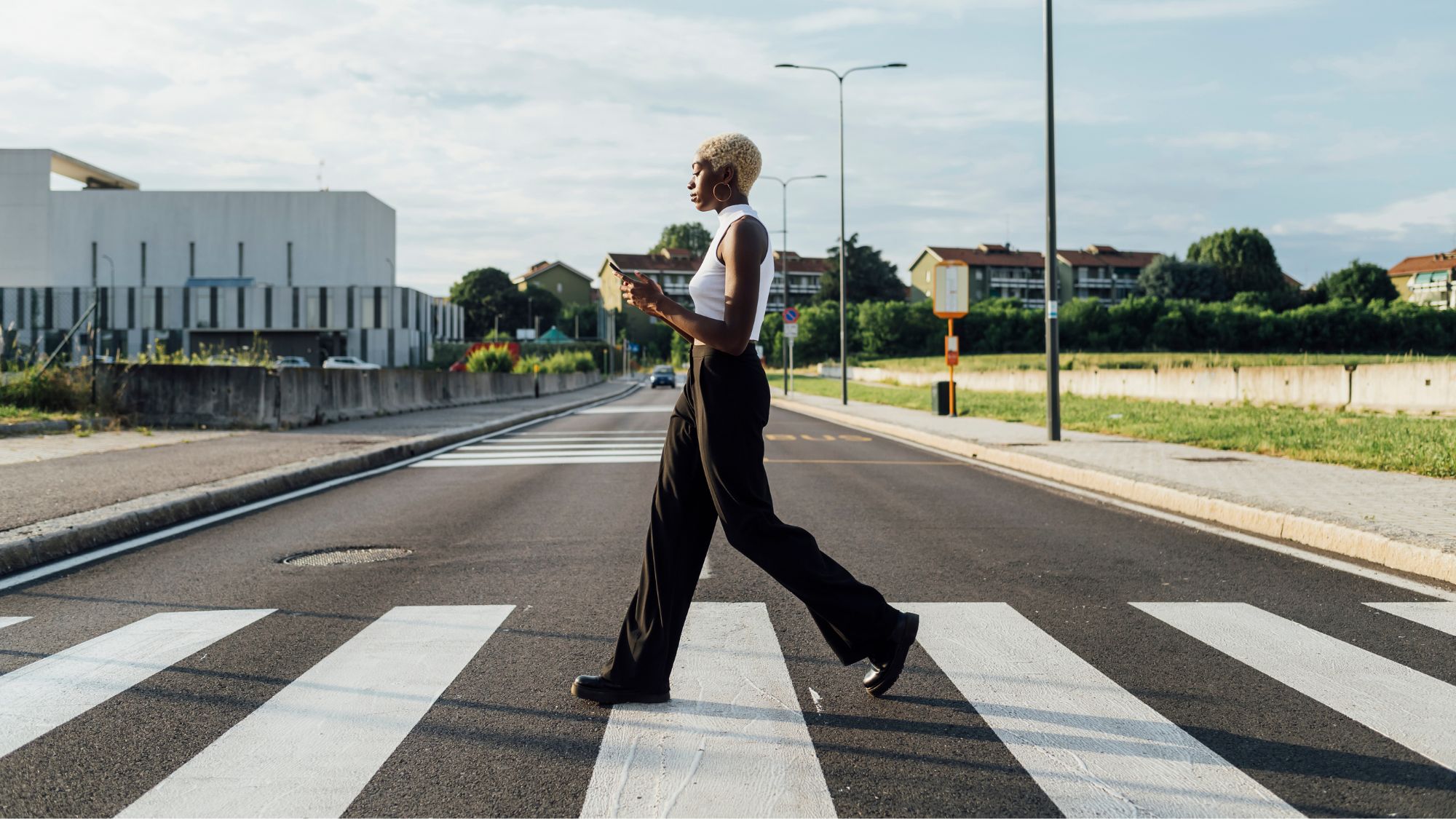A new study has confirmed how many steps to aim for a day - and it's a lot less than you'd think
Optimum health may be more achievable than you thought.

In news today, a new study has discovered how many steps we actually need to be taking a day in order to maintain our fitness levels.
While we've long been told 10,000 is the sweet spot for muscle tone, weight maintenance and more, the study published in the European Journal of Preventative Cardiology suggests that the figure might be significantly lower.
The research - which observed more than 226,000 people across seventeen countries, making it the largest study of it's size to date - found that at least 3,967 daily steps lowered your chance of dying from any cause, while 2,337 daily steps lowered your chances of dying from cardiovascular diseases.
“Our analysis indicates that as little as 4,000 steps a day are needed to significantly reduce deaths from any cause, and even fewer to reduce deaths from cardiovascular disease,” lead author of the study Maciej Banach shared. That said, the more steps you do, the more health benefits you'll see.
At current, the World Health Organisation recommends doing 20 to 40 minutes of walking - around 2,000 to 5,000 steps - or another moderate intensity exercise to maintain cardiovascular health.
Why have we thought 10,000 was the optimum number for so long, then? In short, because of a 1964 pedometer released for sale shortly before the Tokyo Olympics. When deciding how to market the product, the team settled on the number 10,000 as the Japanese character looks like a person walking.
Why is staying active key? Well, “a lack of movement affects your physical health, including tour mobility and metabolism, as well as tour mental health, mood and brain function,” explains Ben Le Vesconte, running coach, personal trainer, and Head Barefoot Movement Coach at Vivobarefoot. “Movement is crucial for a healthy body and brain. It shaped our bodies over millions of years. If we don’t move — a lot — we end up with dysfunctional, likely painful, and injured bodies.”
Marie Claire Newsletter
Celebrity news, beauty, fashion advice, and fascinating features, delivered straight to your inbox!
Keep scrolling for the many other benefits of walking, not to mention handy tips for hitting your daily step count. Don't miss our guides to walking workouts and what happened when our Health Editor tried the Hot Girl Walk, while you're here.
Benefits of walking: 5 pros of lacing up more
1. Maintains metabolism and heart health
There are all kinds of benefits to walking, but on a basic physical level, it can improve our stamina, burn excess calories, make our hearts healthier, and even improve our posture. “Regular walking has a wonderful cumulative effect on our bodies and brains,” says Le Vesconte. “Movement is crucial for metabolism and cardiovascular health.”
2. Easy on our hearts, lungs, and joints
Walking is a form of moderate-intensity or low-impact steady state (LISS) exercise. This means that while it contributes to increased cardiovascular and heart fitness, it puts less stress on your heart and lungs than high-intensity activities, like a HIIT or circuits class.
“As a type of low impact steady-state cardio, walking puts less stress on your joints and as a result is accessible for all different fitness levels and ages,” says Yves Benchimol, CEO of WeWard, an app that rewards your daily steps with discounts at brands like FarFetch, ASOS and coffee shops. “It's one form of low impact steady-state cardio that is an easy way of staying healthy — it can even increase life expectancy!”
3. Keeps stress and anxiety at bay
The benefits of walking can have a major impact on our mental health too, providing fresh air, a change of scenery, and time spent in nature. “Movement can also help control stress, anxiety, attention deficit disorder, addictions and slow down the ageing process,” says Le Vesconte. “In the elderly, movement has even been shown to stimulate brain growth.”
4. Provides connections with others
Going for a stroll can be a great way to get some alone time, whether you feel like getting lost in your own thoughts or tuning into your favourite podcast. But walking can also be an amazing way to connect with others, whether that’s a friend or new people via a hiking group.
5. Better for the environment
Travelling by foot is the most sustainable form of transport, with zero carbon impact. This is what inspired Benchimol to set up WeWard, as the app’s rewards system encourages people to swap public transport or car travel for walking. According to Benchimol, WeWard has already saved 246,950 tons of CO2 and rewarded its users with two million.
4 simple ways to get your steps up
Whether you’re working from home, the office or not working at all, Le Vesconte says that going for a stroll every morning, lunchtime, and evening is a “simple step to better health”. If your commute involves a stretch of walking, you may find that you are moving in this pattern already. The trick is to keep it up even on days spent mostly at home.
“Walk to work. Walk to lunch. Walk home. Then add in more activities which you ENJOY," says Ben Le Vesconte. "I encourage everyone to get out for a good walk before they start their day. We always feel better after a walk. It helps to distinguish between home and work time. Whatever works to get you out the door, do it."
Understandably, many women feel unsafe walking alone, especially after the horrific murders of Sarah Everard, Sebina Nessa, and Ashling Murphy shone a light on the prevalence of male violence against women. A 2021 survey by YouGov revealed that women feel more unsafe walking alone than they did three years ago, with more than two-thirds of women now feeling in danger.
While this is definitely not an issue that women should have to fix, one of the ways we can gain a little peace of mind is by using a street safety app. For example, walking safety app Follo will monitor your journey and alert your loved ones if it detects any worrying signals, like if you stop moving, suddenly start moving at high speed, veer off route, or lose device connection.
1. Aim for three walks a day
When working from home, try to stick to Ben’s rule of taking a walk in the morning, at lunchtime, and in the evening. Could you treat yourself to a coffee from a cafe you can walk to? Remember, getting out for a walk first thing will help set you up for the day.
2. Get rewarded for your steps
Download WeWard and get rewarded for your steps in discounts at brands like FarFetch, ASOS, and coffee shops. The app claims its users walk 24% more with WeWard.
3. Embrace bad weather
Try not to let bad weather get in the way of you reaping the benefits of walking. Dress appropriately and try to embrace whatever the UK skies decide to throw at you! Le Vesconte keeps the following Bob Marley quote in mind to get him outside in all weathers: “Some people feel the rain, others get wet,” or this one from Alfred Wainwright, “There is no such thing as bad weather, only bad clothes”.
4. Make walking a social activity
Rather than meeting a friend in a cafe, why not take your brew to go and enjoy the benefits of walking together? Walking can also be an amazing way to make new pals through a hiking group, such as Ramblers or Black Girls Hike. There are plenty of scenic hikes in the UK if you’re in the mood for an adventure.
Got it? Ready? Set? Steps.
- Ally HeadSenior Health and Sustainability Editor
-
 Prince Harry reportedly extended an 'olive branch' to Kate and William on latest UK trip
Prince Harry reportedly extended an 'olive branch' to Kate and William on latest UK tripBig if true
By Iris Goldsztajn
-
 How Prime Video is protecting Blake Lively amid her new movie promo
How Prime Video is protecting Blake Lively amid her new movie promoAn understandable move
By Iris Goldsztajn
-
 It's the must-have bit of fit kit of the year - a fitness expert shares their top 5 tips for choosing a walking pad
It's the must-have bit of fit kit of the year - a fitness expert shares their top 5 tips for choosing a walking padThis year's fitness must-buy.
By Katie Sims
